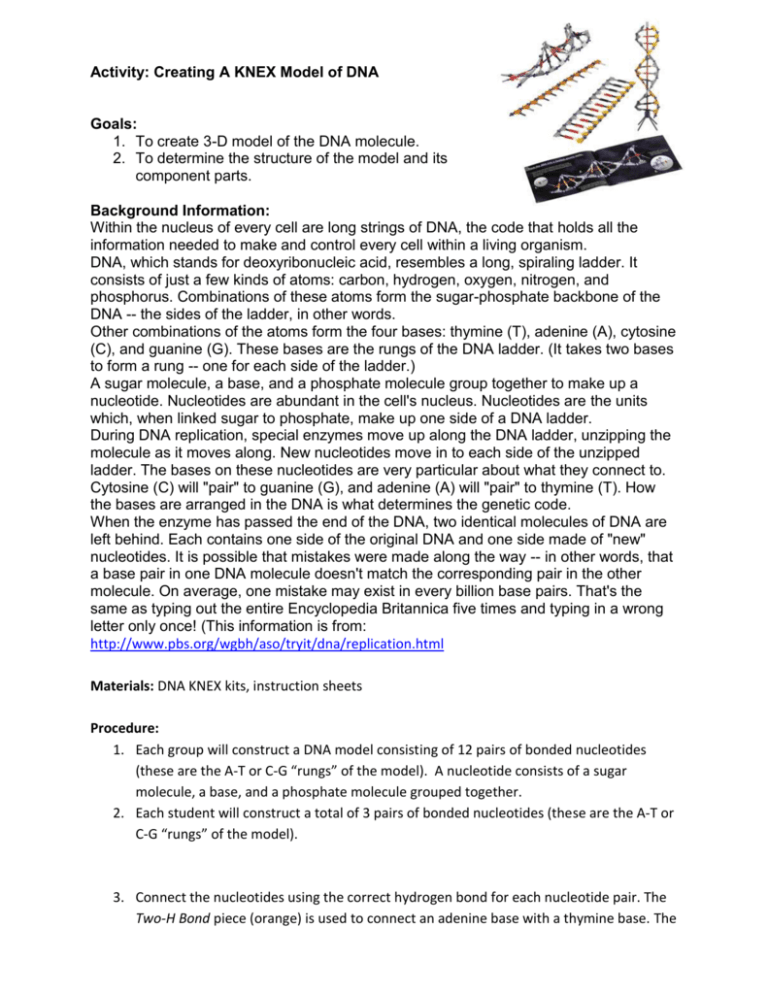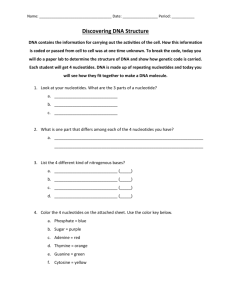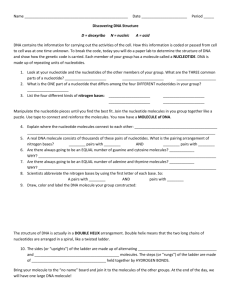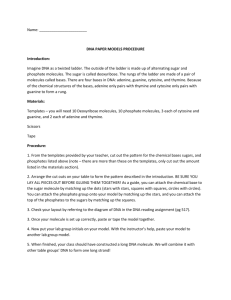Activity: Creating A KNEX Model of DNA
advertisement

Activity: Creating A KNEX Model of DNA Goals: 1. To create 3-D model of the DNA molecule. 2. To determine the structure of the model and its component parts. Background Information: Within the nucleus of every cell are long strings of DNA, the code that holds all the information needed to make and control every cell within a living organism. DNA, which stands for deoxyribonucleic acid, resembles a long, spiraling ladder. It consists of just a few kinds of atoms: carbon, hydrogen, oxygen, nitrogen, and phosphorus. Combinations of these atoms form the sugar-phosphate backbone of the DNA -- the sides of the ladder, in other words. Other combinations of the atoms form the four bases: thymine (T), adenine (A), cytosine (C), and guanine (G). These bases are the rungs of the DNA ladder. (It takes two bases to form a rung -- one for each side of the ladder.) A sugar molecule, a base, and a phosphate molecule group together to make up a nucleotide. Nucleotides are abundant in the cell's nucleus. Nucleotides are the units which, when linked sugar to phosphate, make up one side of a DNA ladder. During DNA replication, special enzymes move up along the DNA ladder, unzipping the molecule as it moves along. New nucleotides move in to each side of the unzipped ladder. The bases on these nucleotides are very particular about what they connect to. Cytosine (C) will "pair" to guanine (G), and adenine (A) will "pair" to thymine (T). How the bases are arranged in the DNA is what determines the genetic code. When the enzyme has passed the end of the DNA, two identical molecules of DNA are left behind. Each contains one side of the original DNA and one side made of "new" nucleotides. It is possible that mistakes were made along the way -- in other words, that a base pair in one DNA molecule doesn't match the corresponding pair in the other molecule. On average, one mistake may exist in every billion base pairs. That's the same as typing out the entire Encyclopedia Britannica five times and typing in a wrong letter only once! (This information is from: http://www.pbs.org/wgbh/aso/tryit/dna/replication.html Materials: DNA KNEX kits, instruction sheets Procedure: 1. Each group will construct a DNA model consisting of 12 pairs of bonded nucleotides (these are the A-T or C-G “rungs” of the model). A nucleotide consists of a sugar molecule, a base, and a phosphate molecule grouped together. 2. Each student will construct a total of 3 pairs of bonded nucleotides (these are the A-T or C-G “rungs” of the model). 3. Connect the nucleotides using the correct hydrogen bond for each nucleotide pair. The Two-H Bond piece (orange) is used to connect an adenine base with a thymine base. The Three-H Bond piece (brown) is used to connect a cytosine base with a guanine base. The following is an easy way to remember which bases are bonded with the appropriate hydrogen bond. A-T TWO - (orange piece) C-G THREE - (brown piece) 4. Connect the “rungs” of the DNA molecule by connecting the phosphate groups (the purple rod with the clip) together. The phosphate groups and sugar molecule will make up the “handrails” of the model. 5. Your DNA KNEX model is now complete! 6. Complete the Word Splash activity. Name ______________________________________ Word Splash (DNA KNEX Activity) Date ___________ Directions: Categorize the following terms in the chart below and then use them to write a paragraph or two that uses the words all of the word splash. DNA replication cell division guanine thymine double helix cancer unwinds interphase Purpose of DNA Paragraph(s) Structure of DNA nitrogen bases adenine cytosine genetic information tumor copies Process of Replication mutation phosphate sugar molecule Problems with Cell Division









